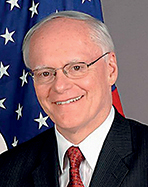 James F. Jeffrey is Philip Solondz Distinguished Fellow at The Washington Institute for Near East Policy and a former U.S. Deputy National Security Advisor.
James F. Jeffrey is Philip Solondz Distinguished Fellow at The Washington Institute for Near East Policy and a former U.S. Deputy National Security Advisor.
WHILE today’s Middle East is wracked by problems that risk destabilizing the region and its enormous energy resources, generating huge refugee flows, horrific terrorist attacks, and even possible NATO-Russia confrontation, sooner or later efforts to calm the region and resolve remaining conflicts will gain a footing.
At such a time, the question of how to “organize success,” and build upon it with institutional tools, will become paramount. Over the past four decades or so, the premier institute encompassing all the states of Europe to accomplish these goals has been the Organization for Security and Cooperation in Europe (OSCE, formerly CSCE). It could provide either direct assistance to, or serve as a model to be drawn on for, the resolution of specific conflicts and the management of crises, as well as underlying disputes, in the Middle East.
The prerequisite to such an institutional approach is a willingness by all states in the region, as well as the major global players, to find a solution, compromise on specifics, and unite—if necessary, violently—against local actors that resist peace and conflict resolution. Achieving that willingness is a task at a global level beyond institutional ‘fixes.’ But clear thinking on what sort of institutional arrangements are available to implement, enforce, and strengthen this willingness is necessary—both to ensure long term success, as well as to provide incentives and assurances to the effort to achieve this initial ‘global willingness.’ The OSCE model offers as good an example as exists in the world today to provide such institutional arrangements.
The Problem
The Middle East today is in virtual free-fall. Following the wars in Southeast Asia in the 1970s, it has become the most dangerous region in the world. Hegemonic pretender states, then-Soviet interference, unresolved ethnic and religious conflicts within states, and, since 1979, revolutionary extremist Islamic movements (both in Iran and within the Sunni Muslim world) have contributed to the region’s chaos.
But for decades this was a ‘chaos that we know,’ with at times difficult (500,000 American troops to resolve the First Gulf War) but feasible courses of action for the United States, the rest of the West, and the West’s partners in the region to restore order—at least on the state-to-state level.
But since 2010 the region has disintegrated more, producing ‘unknown unknowns’ as various pillars of the regional landscape—a strong American engagement (especially in the military realm), relatively stable (even if not liberal) states including Iraq and Syria, restraints on extremist Islamic movements (including the Iranian-backed Shia ‘cause’), and no serious outside interference—have fallen away.
Now the region is in serious crisis with unknown outcomes. Some of this is generated by Islamic movements: al Qaeda, ISIS, more activist elements of the Muslim Brotherhood (e.g. the Egyptian wing, Hamas), as well as Shia groups backed by Iran. Some is generated by Iran’s quest as both ‘a state and a cause’ to seize a dominant position in much of the Gulf and Levant in the wake of a supposedly withdrawing United States. And some of it is the culmination of negative social trends in the Arab world—documented in the UNDP’s 2002 study of the problem, and manifest in the failure of the ‘Arab Spring’ to usher in a transformation of Arab states and societies.







